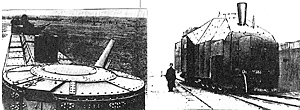 Armored Trains represented a technological leap in capability of both offensive and defensive firepower for Russia in the early part of the 20th Century. The armored train brought heavy firepower, mobility, and even flexibility to an uneducated fighting force. The leadership was educated in the military art, but those who actually used the trains to fight were soldiers with a cause - revolutionaries.
Armored Trains represented a technological leap in capability of both offensive and defensive firepower for Russia in the early part of the 20th Century. The armored train brought heavy firepower, mobility, and even flexibility to an uneducated fighting force. The leadership was educated in the military art, but those who actually used the trains to fight were soldiers with a cause - revolutionaries.
What made the armored train such a wonder is how they were produced. You'll see in this series that there was some rhyme and reason behind their production, but reality says that each train was produced individually. The factories that put these trains together did so as if they were building a Rolls Royce. They machined parts individually in order to fit the armor together or to build a rotating platform on which to mount a gun. The construction started with the engine and expanded to the armored combat car and support car. You can see all that from the various configurations that came about.
The factories that produced the trains used what armaments they could acquire generally naval guns and Maxim machineguns. The more guns, the better protected the train would be. The trains were perfect platforms for this type of weaponry - inherently stable with no suspension problems (as they had with the armored cars). Ammunition would come later and they would carry as much as they could with them - allotting generally 5000 rounds per machinegun and however many rounds could fit for the heavy guns.
It seems that the trains would be canalized and easy to stop from entering a combat area, but more often than not, the trains patrolled areas and prevented exactly those actions. They fought insurgents who would prevent their movement. A group of men trying to pry up tracks are easy pray for an armored train with 20 Maxim machineguns and two pieces of heavy artillery. An armored train could sit in ambush or it could conduct a direct attack.
For example, one tactic used by the Red Army involved three trains. The first train would make a high speed run down the tracks toward the target area, using the shock effect to achieve a breakthrough or to simply disorient the enemy. The second train was a heavy train and was used in a fire support role. The third train covered the rear area to ensure that all trains could withdraw following the attack. Since an armored train carried roughly 300 soldiers, it was more than fire support and shock. It could mop up its own attacks! Or use the infantry to stage an ambush supported with artillery fire from the train.
For this first part of the series, I'll show you the silhouettes that account for all the different variations of Red Army armored trains and some line drawings to show more specific details on certain trains. In the next couple parts, I'll show more line drawings and give more battle examples. Hopefully in the third part to this series, I'll have a couple scenarios, scaled for the best RCW figures - Peter Pig's 15mm.
More Armored Trains of the Red Army during the Russian Civil War
-
Introduction
Armored Guard of the Revolution
Armored Train Configurations (in silouette)
Armored Train Configurations (technical drawings)
Back to MWAN #110 Table of Contents
Back to MWAN List of Issues
Back to MagWeb Magazine List
© Copyright 2001 Hal Thinglum
This article appears in MagWeb (Magazine Web) on the Internet World Wide Web.
Other military history articles and gaming articles are available at http://www.magweb.com